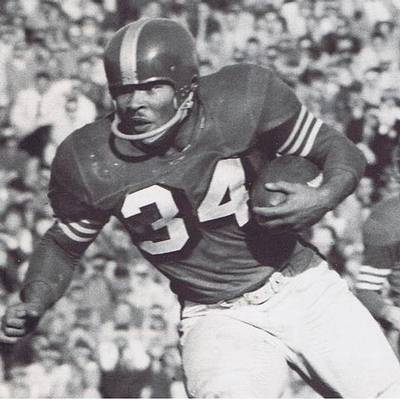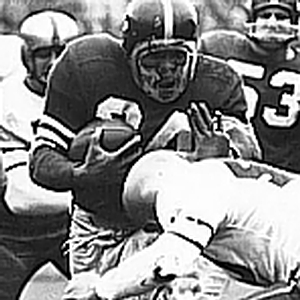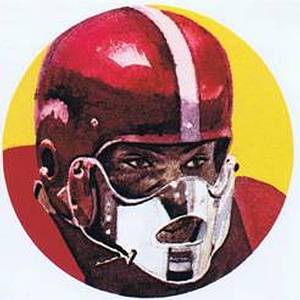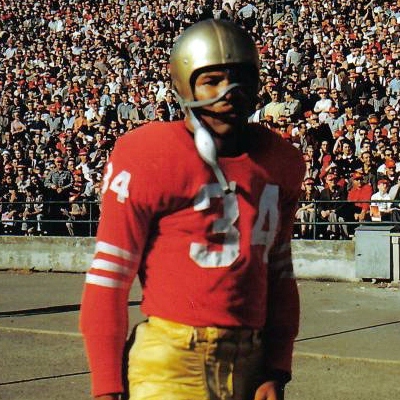

"The Absolutely Great Joe Perry"
HELMET HUT NEWS/REFLECTIONS May 2011:
THE ABSOLUTELY GREAT JOE PERRY
By Dr. Ken
For those of a certain age, our football experience as players and/or fans cuts across the Golden Age of Pro Football of the 1950’s and through the birth and subsequent absorption of the American Football League into the National Football League. By any standard of measure, the fifteen to twenty year period marked by the Fifties and Sixties was truly the very best of times for football. I would argue that the greatest players, the greatest games, the most significant of events that shaped the game and its place in our culture occurred in this time span and both ESPN and The NFL Network be damned. Their “Top X Number” lists are a joke, clearly chosen by individuals whose sense of football history goes back no further than 1965 and only then to pay homage only to the most obvious of great players. Watching these programs and the discussions about great players makes one feel as if their roundtable production meetings follow the path of “Well, we have to include Unitas somewhere on the list so let’s plunk him right about here and then get back to the Marinos and Bradys.” While there are certainly very good and a few great players on today’s field, far too many now entering the Pro Football Hall Of Fame more accurately belong in what the Pro Football Researchers Association refers to as “The Hall Of Very Good.” (allow me to note that the PFRA is definitely an organization you would want to join for a boatload of hard to find, wonderful information, see http://www.profootballresearchers.org/ ).
 |
Too many of the truly great players of half a century ago have all but been forgotten and for those who witnessed his abilities, his deeds, and his influence Joe Perry certainly was one of these. As a member of The Pro Football Hall Of Fame perhaps most readers would think that he is far from forgotten but the magic that he brought to the field of play is not appreciated even by those who first became fans in the late 1960’s and early ‘70’s. His place in social history is certainly lost. Coincidental to my remarks in the preceding paragraph about the recently constructed “Best” lists, in the excellent book Gridiron Gauntlet; The Story Of The Men Who Integrated Pro Football, author Andy Piascik begins his chapter on Joe Perry with the following words:
“Whenever sports pundits talk about the greatest running backs of all time, it is rare that they mention Joe Perry. That is true even when the field is as large as ten, as in the Ten Best Running Backs or Ten Greatest Running Backs. Usually such lists go something like this: Jim Brown, Walter Payton, Barry Sanders, Emmitt Smith, Eric Dickerson, O.J. Simpson, Earl Campbell, Gale Sayers, Thurman Thomas, and Tony Dorsett. Because Joe is almost never on such lists, younger fans are likely to respond to a call for his inclusion by asking, Who the heck is Joe Perry? Well. Consider a few facts and then consider that the better question is, Why the heck isn’t Joe on these lists?”
 |
 |
An artist’s rendition of the mask worn by Joe Perry to protect a broken jaw sustained in the pre-season of 1954
Needless
to
add,
I
could
not
agree
more
and
as
the
first
Black
player
on
the
Forty
Niners,
he
certainly
was
a
ground
breaker
who
represented
all
the
best
qualities
of
an
athlete
and
man.
Born
in
Arkansas
but
raised
in
the
Compton
section
of
Los
Angeles,
Fletcher
Joseph
Perry
was
an
athletic
standout
at
David
Starr
Jordan
High
School,
starting
for
the
varsity
football
team
as a
thirteen
year
old.
Perhaps
it
could
be
stated
that
Perry
began
a
great
athletic
tradition
at
what
was
the
relatively
small
Jordan
High
School,
paving
the
way
for
Olympic
champions
and
world
record
holding
track
performers
Florence
Griffith-Joyner
and
Kevin
Young.
With
his
heart
set
on
attending
UCLA
so
that
he
could
follow
in
the
footsteps
of
his
idol
Kenny
Washington
and
with
the
academic
and
athletic
accomplishments
to
qualify,
he
was
snubbed
by
his
hometown
university.
As
USC
did
not
in
Perry’s
opinion,
seem
to
be
ready
for
Black
football
players,
he
chose
local
Compton
Junior
College
as
his
next
stop.
Future
Pro
Football
Hall
Of
Fame
San
Francisco
Forty
Niner
teammate
Hugh
McElhenny,
another
Los
Angeles
product,
also
played
there
before
embarking
on
his
All
American
career
at
Washington.
After
a
fine
first
season
on
the
field
and
in
the
classroom
as a
math
major,
Perry
enlisted
in
the
Navy
in
order
to
serve
his
country
during
the
Second
World
War.
He
later
noted
that
he
was
not
comfortable
with
the
term
“African-American”
to
describe
his
race.
He
was
clear
that
he
was
“an
American”
who
“served
America”
while
in
the
military.
When
he
returned
from
overseas
he
was
stationed
at
the
Alameda
Naval
Air
Station
where
his
football
exploits
attracted
both
the
NFL
Los
Angeles
Rams
and
the
All
American
Football
Conference
San
Francisco
Forty
Niners.
Though
the
Rams
offered
Joe
more
money,
he
chose
the
Niners
because
of
his
immediate
bond
with
their
owner
Tony
Morabito,
a
man
he
felt
was
like
a
second
father
to
him.
Despite
some
racial
prejudice
shown
towards
him
on
the
field,
Perry
always
was
clear
that
he
was
and
would
be
patient
with
those
who
spoke
badly
towards
him
but
would
not
tolerate
any
physical
punishment
because
of
his
race.
Though
his
49er
backfield
mate
in
later
years,
John
Henry
Johnson,
was
known
far
and
wide
as
perhaps
the
most
intimidating
player
in
the
pro
ranks,
Perry’s
reputation
as a
proud
man
who
would
retaliate
immediately
if
he
believed
his
physical
well
being
was
being
compromised
made
him
very
much
a
highly
respected
individual
among
his
teammates.
Both
Perry
and
other
Niners
of
the
team’s
early
years
stressed
constantly
that
they
were
very
much
a
family
and
that
race
relations
were
quite
good.
Though
the
media
and
NFL
folk
lore
credits
Gale
Sayers
and
Brian
Piccolo
as
being
the
first
racially
mixed
NFL
teammates,
Verl
Lillywhite
and
Perry
actually
were
the
ground
breakers
and
the
ongoing
example
Perry
set
from
his
entry
to
pro
football
in
1948
until
his
retirement
after
the
’63
season
could
have
served
as a
template
for
others
seeking
the
same
type
of
social
success.
 |
On
the
field,
Joe
Perry’s
unselfish
approach
to
the
game
stood
out
as
much
as
his
abilities
to
run
the
ball
for
a
Pro
Football
Hall
Of
Fame
total
of
8378
rush
yards.
Though
he
always
believed
that
his
two
year
AAFC
statistics
and
that
of
the
other
league
players
should
have
been
included
with
his
overall
pro/NFL
accomplishments,
Perry
knew
his
worth
and
was
justly
proud
of
his
body
of
work.
He
understood
that
he
was
a
ground
breaker
as
the
first
NFL
running
back
to
have
consecutive
1000
yard
rushing
seasons
at a
time
when
that
specific
statistic
truly
was
a
fantastic
feat.
He
also
understood
that
it
was
his
job
to
block
like
a
demon
when
sharing
the
“Million
Dollar
Backfield”
with
three
other
Hall
Of
Fame
players
in
John
Henry
Johnson,
Hugh
McElhenny,
and
Y.A.
Tittle
and
that
ball
carrying
chores
would
not
fall
just
to
him.
In
typical
fashion,
he
did
his
job
as
well
as
it
could
be
done.
Still,
from
1949
through
the
’55
season
he
was
the
Niners
leading
rusher
and
the
center
of
the
offensive
attack
that
was
always
one
of
the
league’s
best.